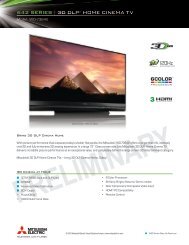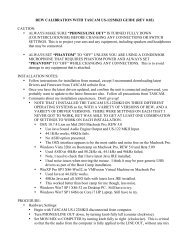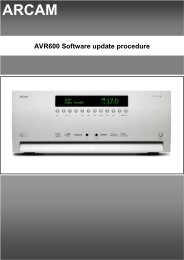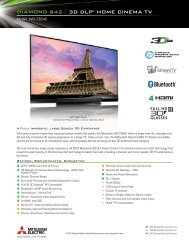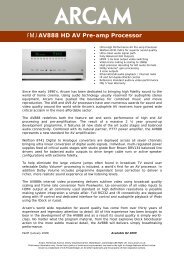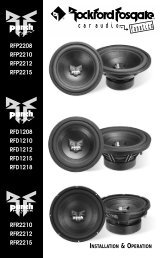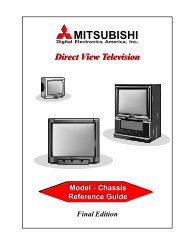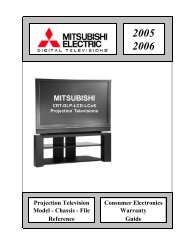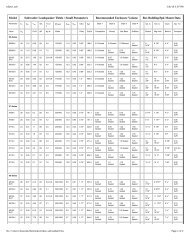AccuCal Front Projection Screen Report.pdf - Home Theater Shack
AccuCal Front Projection Screen Report.pdf - Home Theater Shack
AccuCal Front Projection Screen Report.pdf - Home Theater Shack
Create successful ePaper yourself
Turn your PDF publications into a flip-book with our unique Google optimized e-Paper software.
Test Conditions<br />
<strong>AccuCal</strong><br />
This room had no windows, dark walls, equipment rack was in the hall not facing screen and minimal light sources were present in the room. All<br />
room lighting was off at the time of the tests. The most significant light source was a PC that was dimmed, in the back of the room and facing the<br />
rear of the room. Background light sources with the projector off were measured to add 0.000073 fL to the Carada Classic Cinema White screen.<br />
All color and screen luminance measurements were made with the PR-670 carefully positioned and tripod mounted to measure an area that was<br />
projected as a target from the projector. This was true for both luminance and illuminance measurements. The same measurement series taken at<br />
the beginning of the test was also repeated at the end to help ensure that nothing had drifted significantly.<br />
The Carada Classic Cinema White screen used in these tests is the screen installed in this theater. All other screen materials in these tests were<br />
samples from Da-Lite. <strong>Screen</strong> gain measurements could be influenced by the screen samples not being tensioned like the Carada. Multiple attempts<br />
were made to position the sample to keep the sample flat in the area being measured. All screen samples were taped to the Carada screen for<br />
measurement. Only one screen sample was used for each screen material tested. None of the samples appeared to be damaged.<br />
The projector in this case was ceiling mounted in the center of the screen horizontally and vertically above the screen. Maximum vertical shift was<br />
used in this product. The projector was also warmed up for 2 hours before color measurements were taken to stabilize the output colors as much as<br />
possible. The spot measured was 32.5” lower than the projector’s center of projection. The projector was also on high lamp mode and the image<br />
sized for an 86” diagonal 16:9 screen near the minimum throw of the projector. This provided a bright image to maximize the signal to noise ratio<br />
of the measurements.<br />
The test patterns used to measure light output and color were all created by an Accupel HDG-4000. The patterns used were window patterns to<br />
minimize the scattered light sent to the walls, floor and ceiling. The colors measured included red, green, blue, yellow, magenta, cyan, desaturated<br />
blue, desaturated green, desaturated red and white.<br />
The PR-670 was set to measure a 1 degree field of view and extended range with the smart dark feature off. The PR-670 was AC powered during<br />
these tests. Actual screen light levels measured between 0.4 fL and 16.5 fL. At no time did the PR-670 report a value as being out of range. Nominally<br />
the light levels ranged between 1 fL and 10 fL The MS-75 lens attachment was used to measure the screen and a CR-670 cosine corrector<br />
was used to measure the light from the projector directly.<br />
<strong>Screen</strong> material observations were made in normal room lighting and with light from the projector. <strong>Screen</strong> observations included test patterns and a<br />
variety of movie material. Observations of movie images were made at 9’ at 18 degrees off center and sitting at the center of the screen with an 86”<br />
diagonal image and a maximum light level of 15 fL from the Classic Cinema White screen.<br />
No measurements were attempted to measure hot spotting because these problems can vary with the projector, but screens with more gain tend to<br />
have more issues with luminance varying with the location of the image on the screen. Retroreflectors like the High Power tend to have fewer<br />
problems with this than other high gain options.<br />
Audio was measured with an ACO Pacific MK224PH Class I microphone and Sencore SP495 preamp at 1/24 octave. The microphone was positioned 24 inches<br />
from the tweeter and on axis with it. The screen material was 3 inches from the tweeter. Wideband pink noise was measured with and without the material in the<br />
sound path and the difference was taken using TrueRTA. Strong problems with comb filtering were observed when the material was positioned very<br />
close to the speaker which is not recommended by the manufacturer. This caused an additional 6db variation from 5 to 20 kHz. A Class 1 microphone<br />
was used to reduce the interaction with the room at these frequencies. The background noise was NCB 19.<br />
5




